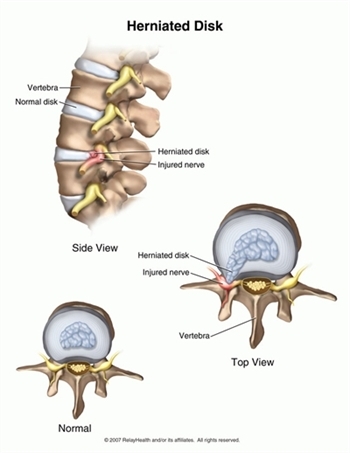Herniated disc
A disc is a soft, rubbery pad that cushions the vertebral bones in the spinal column. This prevents the bones from rubbing against one another and allows for movement, such as bending or flexing.When we look up close at a disc from the top-down, we can see that discs are made up of an outer ring of cartilage, and an inner ring of a gel-like substance, where the nucleus resides. This pad sits directly in front of the spinal canal, which allows the spinal cord to run from the brain down to the end of the spine.
A herniated disc, commonly referred to as a 'ruptured' disc, can cause pain in the neck, lower back, arms, or legs.
Cause:
When the nucleus of the disc expands, it splits or ruptures causing the gel-like substance of the nucleus to leak out. This can be the result of daily wear and tear on the spine, incorrect lifting or twisting that aggravates a weak disc, but it can also be caused by an injury or pinched nerves that progress in severity over time.
Risk Factors:
Aging (individuals between 30-50 are at high risk)
As children, discs in the spinal column have high water content, which means that discs are more flexible. The water content, however, decreases with age. As the discs shrink, the cushioning between the vertebrae gets smaller, weakening them.
Additional conditions that can weaken discs are:
Excessive body weight that adds stress to the discs, particularly in the lower spine
Improper lifting of heavy objects
Repetitive physically strenuous activities
Symptoms:
dull or sharp pain
loss of bladder and/or bowel control, which are indicative of Cauda Equina
muscle spasm or cramping
tingling (pins and needles)
weakness
one leg - when pain occurs in the lower backdiscs
one arm - when pain occurs within the neck
Diagnosis:
Medical History: prior injuries, neck/back pain that has gradually increased over time
Physical Examination: used to determine where the pain occurs, while also assessing what nerve roots are implicated and how seriously.
Diagnostic Imaging
MRI
CT Scan
Treatment:
After nonsurgical treatment, most patients (90%) with herniated discs heal over time (1-6 months).
Nonsurgical Treatment:
Rest for a period of time, followed by a gradual increase in activity
Medication to control the inflammation and pain
Physical Therapy
Exercises recommended to reduce pain and increase strength in the muscles that support the spine, preventing further injuries
Resorption: The body can reabsorb the tissue or fragments from a herniated disc that has ruptured, essentially healing itself.
Surgical Treatment:
Required in less than 10% of patients who suffer from a herniated disc.
Surgery may be recommended for individuals who have severe weakness or numbness, pain that cannot be relieved, or have progressive nerve damage.

